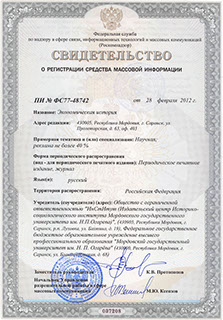Экономическая историЯ
Russian Journal of Economic History
ISSN 2409-630X (Print)
ISSN 2618-916X (Online)
Expert board:
- Scientific Council of RAS on economic history;
- Research and Educational Center «The economic history of Central Russia and the Middle Volga region» of Ogarev Mordovia State University;
- Center of Economic History of Lomonosov Moscow State University
Navigation
Certificate of registration

ISSN 2409-630X (Print), ISSN 2618-916X (Online)
DOI: 10.15507/2409-630X.063.019.202304.305-317
Alexey V. Kuznetsov
Plekhanov Russian University of Economics (Moscow, Russia),
e-mail: isikuzav@mail.ru
Comparative and Historical Analysis of the Principles of Stimulating the Economy during the Crisis Period (Middle Bronze and Modern Times)
Abstract
Introduction. The comparative analysis contained in the work is devoted to the limitations of the dependence of socio-political processes and economic conditions on historical and anthropogenic factors. Now we witness the instability of the global system, overheated by specific contradictions, phobias and crises. Falling stock indices, the threat of default, growing international problems, climate oscillations – all this forces society to look for a way out of the crisis.
Purpose. Only at the level of transdisciplinary approaches can one calculate accurate and consistent data that allows one to develop fundamental knowledge of the subject in order to implement a predictive function for choosing a development concept and determining a management strategy.
Materials and Methods. This study, carried out with the requirements of a retrospective analysis, draws attention to the most striking aspects of the economic policies of the Roosevelt administration in the 1930s, past experience and similar principles created from the sources of the era of the III Dynasty of Ur.
Results. A real historical comparative analysis of various socio-economic models depending on natural and climatic changes. Methods for overcoming the crisis in the most difficult period of the Bronze Age (III Dynasty of Ur), caused by fluctuations in the Bond cycle, have been identified. Comparisons of the administrative forms regulating the national economy of the Third Dynasty of Ur and the state-monopoly capitalism of F. Roosevelt’s New Deal.
Discussion and Conclusion. The author knows the meaning of the saying “Omne simile claudicat”. Despite the same nature of the crisis trends that led to an unexpected turn, in which the role of the government in the economic activity of society is manifested, the concept of stimulating the national economy in these two cases is equally similar. And if they are truly intended and repeated, then there are opportunities to consider them in the present or future as a leading concept for economic development.
Keywords: Contemporary crisis, observable-historical analysis of past crises, Roosevelt’s New Deal, Ur-Nammu laws, climate history, climate oscillations.
For citation: Kuznetsov A. V. Comparative and Historical Analysis of the Principles of Stimulating the Economy during the Crisis Period (Middle Bronze and Modern Times). Ekonomicheskaya istoriya = Russian Journal of Economic History. 2023; 19(4): 305–317. (In Russ.). DOI: 10.15507/2409-630X.063.019.202304.305-317.
© Ogarev Mordovia State University. History and Sociology Institute, 2017
68, Of. 411, Bolshevistskaya St., 430005, The editorial office of the scholarly journal «Russian Journal of Economic History»
Tel.: (8342) 24-25-90; 27-07-11, Fax: (8342) 24-25-90, E-mail: jurnal-econom-hist@isi.mrsu.ru
Designed by A. Napalkov, Email: napalkov@isi.mrsu.ru

